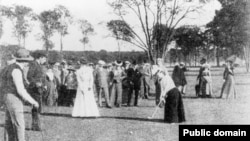Since the introduction of the modern Olympics 1896, and the addition of the Winter Olympics in 1924, the popularity of sports has changed. At each Olympiad, new events are added and some sports retired.
Following the 2008 Beijing Games, two sports - softball and baseball - were cut from the Olympic program.
Notable new events at the 2012 London Olympics are women's boxing (three weight classes), mixed doubles in tennis and Omnium racing in track cycling.
Some popular sports find their way into the Olympics; some don’t.
Golf was featured in the 1900 and 1904 games, but then it disappeared. However, the IOC has decided to reinstate the event for the 2016 Olympics in Rio de Janeiro, and many professional golfers have expressed interest in participating.
Bowling is not an Olympic event and there is no timeline for adding it. However, bowling has been an event in the Special Olympics since 1975.
Many Olympic sports have come and gone over the last 116 years. Here are a dozen or so Olympic sports that are now forgotten:
Live Pigeon Shooting
The 1900 Olympics in Paris had a number of odd events by today's standards. Perhaps the oddest was this one, in which the competitor who shot down the most live birds was declared the winner. Nearly 300 birds were killed and the competition field was reportedly littered with blood and feathers. It was the only time in Olympic history in which animals were killed on purpose.
Tug-of-War
Originally a sport in the Ancient Olympics, Tug-of-War was contested from 1900-1920. Two teams pulling in opposite directions on a rope tried to drag their opponents over a line separating the teams. The number of participants on a team varied over the years, and contestants from different countries could participate on one team.
Solo Synchronized Swimming
It may sound like an oxymoron, but this sport was contested in three Olympiads (1984, 1988, 1992) before organizers realized that a person swimming alone cannot be synchronized with anyone else.
One-Handed Weightlifting
This weightlifting event was on the Olympic Program in the years 1896, 1904 and 1906. Only one hand was allowed in lifting the weights. Contestant had to perform lifts with each hand, with the winner determined from the combined score of both hands.
Skijöring (skiing behind horses)
A demonstration sport at the 1928 Olympics in St. Moritz.
Swimming obstacle race
Another 1900 Paris event, the competitors had to climb over a pole, scramble over a row of boats, and then swim under another row of boats…for a total distance of 200 meters. The swimmers also had to contend with the strong current of the Seine River.
All Around Dumbbell
Surprisingly, given its name, this was not an invention for the 1900 Paris games. In 1904, this event attempted to determine the strongest of the strong by compiling 10 different lifting events over two days of competition.
Discus (Two Hands) & Javelin (Two Hands)
These events held in 1912 are not as unusual as they sound. The participants were not required to throw the implement with two hands, but throw it with each hand, and the combined score of each hand was used to determine the winner.
Rope Climb
Rope Climbing was held as part of the gymnastics program in 1896, 1904, 1906, 1924 and 1932. In this event the competitors climbed a suspended vertical rope, using only their hands. How quick you can climb a rope sounds like a great test of upper body strength, and it has been part of the Olympic gymnastics program on several occasions
Plunge Diving
At the 1904 Olympics, competitors dove into the pool from a standing position and their attained distance was measured after either 60 seconds passed or their head broke the surface, whichever came first. Divers could not propel themselves through the water after the initial dive as they were required to remain motionless.
Equestrian High Jump and Long Jump
Chariot Races were part of the Ancient Olympics. In the modern Olympics, originally only commissioned officers were allowed to compete. From 1952 the rules were changed to allow civilians and women. The winning horses were both able to clear 1.85 meters in height and leap 6.1 meters in length.
Croquet
In the 1900 games, women were competitors for the first time, and three women took part in this event. Not a big hit with the spectators, only one fan watched, an Englishman who had travelled especially for the occasion.
Following the 2008 Beijing Games, two sports - softball and baseball - were cut from the Olympic program.
Notable new events at the 2012 London Olympics are women's boxing (three weight classes), mixed doubles in tennis and Omnium racing in track cycling.
Some popular sports find their way into the Olympics; some don’t.
Golf was featured in the 1900 and 1904 games, but then it disappeared. However, the IOC has decided to reinstate the event for the 2016 Olympics in Rio de Janeiro, and many professional golfers have expressed interest in participating.
Bowling is not an Olympic event and there is no timeline for adding it. However, bowling has been an event in the Special Olympics since 1975.
Many Olympic sports have come and gone over the last 116 years. Here are a dozen or so Olympic sports that are now forgotten:
Live Pigeon Shooting
The 1900 Olympics in Paris had a number of odd events by today's standards. Perhaps the oddest was this one, in which the competitor who shot down the most live birds was declared the winner. Nearly 300 birds were killed and the competition field was reportedly littered with blood and feathers. It was the only time in Olympic history in which animals were killed on purpose.
Tug-of-War
Originally a sport in the Ancient Olympics, Tug-of-War was contested from 1900-1920. Two teams pulling in opposite directions on a rope tried to drag their opponents over a line separating the teams. The number of participants on a team varied over the years, and contestants from different countries could participate on one team.
Solo Synchronized Swimming
It may sound like an oxymoron, but this sport was contested in three Olympiads (1984, 1988, 1992) before organizers realized that a person swimming alone cannot be synchronized with anyone else.
One-Handed Weightlifting
This weightlifting event was on the Olympic Program in the years 1896, 1904 and 1906. Only one hand was allowed in lifting the weights. Contestant had to perform lifts with each hand, with the winner determined from the combined score of both hands.
Skijöring (skiing behind horses)
A demonstration sport at the 1928 Olympics in St. Moritz.
Swimming obstacle race
Another 1900 Paris event, the competitors had to climb over a pole, scramble over a row of boats, and then swim under another row of boats…for a total distance of 200 meters. The swimmers also had to contend with the strong current of the Seine River.
All Around Dumbbell
Surprisingly, given its name, this was not an invention for the 1900 Paris games. In 1904, this event attempted to determine the strongest of the strong by compiling 10 different lifting events over two days of competition.
Discus (Two Hands) & Javelin (Two Hands)
These events held in 1912 are not as unusual as they sound. The participants were not required to throw the implement with two hands, but throw it with each hand, and the combined score of each hand was used to determine the winner.
Rope Climb
Rope Climbing was held as part of the gymnastics program in 1896, 1904, 1906, 1924 and 1932. In this event the competitors climbed a suspended vertical rope, using only their hands. How quick you can climb a rope sounds like a great test of upper body strength, and it has been part of the Olympic gymnastics program on several occasions
Plunge Diving
At the 1904 Olympics, competitors dove into the pool from a standing position and their attained distance was measured after either 60 seconds passed or their head broke the surface, whichever came first. Divers could not propel themselves through the water after the initial dive as they were required to remain motionless.
Equestrian High Jump and Long Jump
Chariot Races were part of the Ancient Olympics. In the modern Olympics, originally only commissioned officers were allowed to compete. From 1952 the rules were changed to allow civilians and women. The winning horses were both able to clear 1.85 meters in height and leap 6.1 meters in length.
Croquet
In the 1900 games, women were competitors for the first time, and three women took part in this event. Not a big hit with the spectators, only one fan watched, an Englishman who had travelled especially for the occasion.








